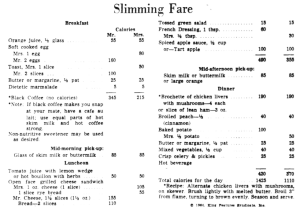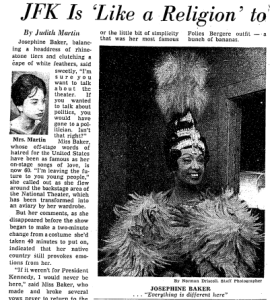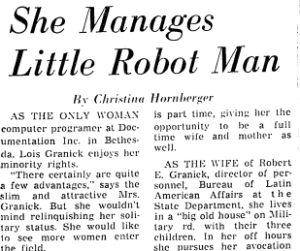For those interested in cultural and social history, one of the most invaluable resources made available through the University of Illinois Library are the historical newspaper databases. Containing the decade-spanning backfiles of such major newspapers as The New York Times, The Washington Post, and The Chicago Tribune, these databases provide readers the opportunity to envision what it might have been like to live during a certain era and experience world-changing events as they were initially recorded.
Paging through the archives of newspapers like The Washington Post, it is possible to find not simply a time capsule capturing the past as it was, warts and all, but also a time lapse through which you can effectively trace the evolution of cultural values and norms over the years. One place where you can find an example of this uphill battle towards progress is within the so-called “women’s pages”, a staple in many newspapers since the late 19th century. In The Washington Post, the “For and About Women” section, which was eventually phased into the “Style” section in 1969, offers a glimpse into the state of the burgeoning women’s movement during the sixties–a time of great political and cultural upheaval and transformation regarding civil rights, gender equality, and more.

That there should be a section of the newspaper devoted to news “for and about women” underscores the drastic separation between what was considered to be the sphere of men and the sphere of women. News for men, or simply “the news,” dealt with politics and the economy and important world events. But browsing the women’s section, it is evident that the publishers of many newspapers had a rather superficial view of where women’s interests lay. The content usually featured fashion advertisements, puff pieces about the wives of influential men, childrearing and housekeeping advice, and marriage and engagement notices. In reading this section, we might find ourselves wondering: Who is the woman for whom this news is “for and about” anyways?
In 1964, the Equal Rights Amendment would not be sent to state legislatures for another eight years. Harvard would not become fully coed for another 13 years and women would not be able to own credit cards separate from their husband’s for another decade. The women’s movement didn’t seem to be moving very quickly. But while much of the content in the women’s section continued to reinforce stringent gender roles and underscore the separation between male and female interests, a hint of what might be coming next can still be found. As women increasingly entered the workforce and proved active participants in the political and social movements occurring during the sixties, the news also began to adapt to keep up with the changing times. The following selection of articles in the women’s section of The Washington Post spotlight women who defied the gender roles of the 1960s in different ways. In examining their coverage, we can gain useful insight into the limitations and biases faced by women during this time, and additionally take notice of where strides appear to have been made even in the face of those obstacles.


Judith Martin interviews Josephine Baker, pg. C1
Consider the article from the first page of the “For and about Women” section of the March 19, 1964 issue of The Washington Post. The reporter Judith Martin interviews Josephine Baker, a French and African-American dancer, singer, and actress. In addition to her highly lauded work in the theater, Baker was an active participant in the civil rights movement during the 1950s and 60s, having spoken at the side of Reverend Martin Luther King Jr. at the famous March on Washington in 1963.
The 1964 article mentions her participation in the march, with Baker stating: “That never would have been possible without President Kennedy.” We are also given a description of Baker’s outfit at the march: a “trim gray suit”, the military uniform from her time participating in the French resistance during World War II. However, it is her effusive praise of the recently assassinated President John F. Kennedy and his legacy which is at the forefront of the article, as exemplified by the headline “JFK Is ‘Like a Religion’ to la Baker.” Although one cannot be certain of the reasoning behind these editorial choices, it would perhaps be easy to speculate that Baker’s more controversial political views on issues such as desegregation might not have been considered appropriate material to be published on a less serious forum like the women’s section.
The issue of credibility is one often faced by media sources centered around content, like fashion or popular culture, viewed by the general public as frivolous. When these publications attempt to break form and wade into political waters, they risk potential backlash. Female-centered publications may be particularly susceptible to this form of criticism, as seen in the response to magazines like Cosmopolitan or Teen Vogue which in recent years have transitioned to featuring more articles on hot-button political and cultural issues like racism and reproductive rights.

In the same issue of The Washington Post, reporter Sue Cronk spotlights Marian Wynn Perry Yankauer, the new chief of special projects for the Civil Rights Commission’s Division of Liaison and Information. The article discusses Yankauer’s work in the NAACP as an assistant to head of the Legal Defense Fund, during which time she researched and wrote briefs relating to school desegregation cases under the guidance of future Supreme Court justice Thurgood Marshall, while also emphasizing Yankauer’s status as a mother and a wife in addition to a civil servant.
Yankauer cites her domestic commitments as her reason for leaving the NAACP, stating that her work there “wouldn’t make it possible to have the kind of marriage I wanted.” Following a relocation to Albany due to her husband’s work, Yankauer began setting up a lobbying service for underfunded public service organizations “as soon as she got Becky into nursery school.” Although one should not form any assumptions about Yankauer’s attitude towards gender roles on the basis of these quotations, the double bind she seems to have confronted, in which her professional ambitions had to be weighed against her responsibilities as a wife and mother, is not unfamiliar and was undoubtedly experienced by many women who chose to enter the workforce during that era.

In a third article, reporter Christina Hornberger interviewing computer programmer Lois Granick distinguishes Granick’s status as the sole female programmer at her company in strictly positive terms, stating in the first paragraph that Granick “enjoys her minority rights.” The first two adjectives used to describe Granick are “slim and attractive.” In the article, the programmer discusses her desire to see more women entering the field of computer science, saying that, “any woman who manages the family budget and bank account has the basic equipment to be a computer programmer.” Granick, describing herself as “very mechanical,” adds that she “likes to fix things around the house.”
These quotes embody the collision of two worlds once thought to be strictly separate–the world of menial domestic tasks (almost always completed uncompensated by women) and the male-dominated world of great scientific and technological innovation. As a woman existing in the overlap between the two, Granick may have proven difficult for some readers to reconcile, which could be why the article seems less interested in describing her projects as a computer programmer and significantly more interested in describing the ways in which Granick conforms to the model of the domestic woman. Like Yankauer, she is a “full-time wife and mother.” She is also a seamstress who designs her own clothes and a soloist at her church.
Baker, Yankauer, and Granick were all certainly interesting women and worthy subjects, but their coverage in the women’s section displayed the stark contrast between how men were written in the news versus women. Would a male computer programmer be described as “slim and attractive?” How many sentences in an article about a trailblazing male performer and activist would be devoted to his wardrobe choices? Would any reporter feel the need to ask how a male political figure maintained both his career and family duties–and if he had singled his career as his primary ambition, would he have been subjected to criticism? As consumers of the news, whether we are digging through decades-old archives or reading articles published in the year 2023, it is always pertinent to be aware of the way bias, unconscious or otherwise, can creep in through choices of language and narrative.
The women’s section of the news may have more often than not reflected the traditional gender roles of the time period in which it was published, but it was also an important landmark paving the way towards more female-centered content in the media, which in recent years has come to apply a broader scope to define “women’s interests.” It can be argued that a gendered division of news will always be sexist, and The Washington Post has since retired its “For and About Women” section, but its proponents still do exist. Most notably, Judith Martin, who wrote the article interviewing Josephine Baker in 1964 and who would eventually gain recognition–and a National Humanities Medal– for penning the widely syndicated “Miss Manners” advice column, published a defense of the ‘women’s pages’ in The Washington Post.
“The women’s section reported the feminist revolution of the 60s and 70s when other parts of the paper mentioned it rarely and then only as a joke,” Martin wrote. “The Women’s Strike for Peace was ridiculed as being a bunch of housewives who should have stayed home but we took them seriously long before their actions grew into the wider youth movement protesting the war in Vietnam.”
Martin goes on to describe the journalistic opportunities she received due to her work reporting for the “For and About Women” section, attending embassy parties and meeting public figures like diplomats and politicians, often gaining more access than her male peers due her subjects’ lack of awareness that the “young woman in a party dress” asking them questions was, in fact, a reporter from The Washington Post.
Whether or not the women’s pages should be relegated to history or reappraised as secretly feminist all along, we as modern readers can be grateful to have access to these rich archives of material. Through studying the past, we can gain a deeper appreciation of how far we have come, while also acknowledging how much further still we have to go.
References:
Cronk, S. (1964, Mar 19). “She’s Traveled Far in Civil Rights: From the Picket Line To a Government Office.” The Washington Post, Times Herald (1959-1973) https://www.proquest.com/historical-newspapers/shes-traveled-far-civil-rights/docview/142312454/se-2
Hornberger, C. (1964, Mar 19). “She Manages Little Robot Man.” The Washington Post, Times Herald (1959-1973) https://www.proquest.com/historical-newspapers/she-manages-little-robot-man/docview/142328524/se-2
Martin, J. (1964, Mar 19). “JFK Is ‘Like a Religion’ to la Baker.” The Washington Post, Times Herald (1959-1973) https://www.proquest.com/historical-newspapers/jfk-is-like-religion-la-baker/docview/142316371/se-2
Martin, J. (2014, Dec 12). “Judith Martin: In defense of ‘women’s pages.'” The Washington Post https://www.washingtonpost.com/lifestyle/magazine/judith-martin-in-defense-of-womens-pages/2014/11/25/f0fcc3a2-645c-11e4-bb14-4cfea1e742d5_story.html
Recommended library resources for further research:
ProQuest Historical Newspapers
- Database containing 46 ProQuest Historical Newspaper titles owned by the University of Illinois, including The Washington Post, The New York Times, The Chicago Tribune, among others.
- Archival research resource comprising the backfiles of leading women’s interest consumer magazines. Subject coverage includes consumer culture, family life, fashion, popular culture, and more
- Backfile of Rolling Stone magazine from 1967 to present. Subject coverage includes music, politics, counterculture, entertainment, and more.
- A four-year project to digitize over one million pages from the magazines, journals, newsletters, and newspapers of the alternative press archives of participating libraries spanning the 1960’s to the 1980’s. Starting with collections by feminists and the GI press, the collection will grow to include small literary magazines, underground newspapers, LGBT periodicals, the minority press (Latino, Black and Native American) and the extreme right-wing press
- Harp, Dustin. Desperately Seeking Women Readers : U.S. Newspapers and the Construction of a Female Readership. Lanham, MD: Lexington Books, 2007. Print.
- Mills, Kay. A Place in the News : from the Women’s Pages to the Front Page. 1st ed. New York: Dodd, Mead, 1988. Print.
- Schreiber, Rachel. Modern Print Activism in the United States. Farnham, Surrey, England : Ashgate, 2013. Print.
- Tusan, Michelle Elizabeth. Women Making News : Gender and Journalism in Modern Britain. Urbana: University of Illinois Press, 2005. Print.
- Voss, Kimberly Wilmot. Re-Evaluating Women’s Page Journalism in the Post-World War II Era : Celebrating Soft News. Cham, Switzerland: Palgrave Macmillan, 2018. Print.
- Watson, Martha. A Voice of Their Own : the Woman Suffrage Press, 1840-1910. Tuscaloosa: University of Alabama Press, 1991. Print.